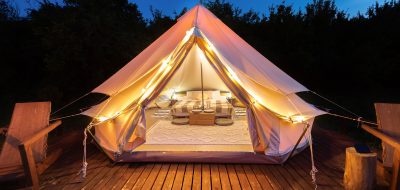Given the rash of severe weather that’s been striking the United States and Canada this spring and summer, it would be prudent for all campers and RVers to have a quick exit plan in place regardless of where you travel.

Following heavy rains in the mountains a wash separating the campground from the entrance road at Catalina State Park near Tucson flooded stranding campers for several days. © Rex Vogel, all rights reserved
Water is a major feature at numerous campgrounds and RV parks. Many state and provincial parks and other public recreation areas are in low-lying areas that are susceptible to flooding during periods of heavy precipitation.
Access to current weather reports and related information—weather radio, mobile wireless phone, satellite radio—will enable campers to be on top of the weather and to take proactive measures in the event of high waters, flood, thunderstorms, or other severe weather conditions.
Be Prepared
Be prepared for changing weather conditions.
Make sure your fire alarms and carbon monoxide detectors have fresh batteries installed.
Keep the RV and toad or tow vehicle fuel tank, propane tank, and fresh water tank filled.
Maintain the correct air pressure in the RV and toad or tow vehicle tires.
Travel with a wireless mobile phone and charger, GPS navigation system, adequate maps, and a good road atlas.
Always carry a first aid kit in your RV. Whether you buy a ready-made first aid kit or put together your own, be sure to keep it well stocked.

Following a path cleared by state park staff, RVs were able to leave Catalina State Park. © Rex Vogel, all rights reserved
Include items such as adhesive bandages in assorted sizes, sterile gauze pads (dressings) in small and large squares, adhesive tape, antiseptic solutions (such as hydrogen peroxide), antiseptic wipes, antibiotic cream, anti-itch cream, burn cream, throat lozenges, cold pack, thermometer, scissors, tweezers, safety pins, disposable non-latex gloves, and triangular bandages to hold dressings in place or to make an arm sling.
Don’t forget to include a first-aid manual.
Travel with an adequate supply of prescription medications.
Maintain a well-stocked emergency supply kit that includes extra blankets, non-perishable packaged or canned food items, bottled water, garbage bags, manual can opener, flashlights, spare batteries, extra medication, protective weather apparel, and any other personal items needed for an emergency.
Tools to keep handy include booster (jumper) cables, road flares, wrenches, screwdrivers, pliers, and duct tape.
At the RV Park
Formulate an emergency plan once you arrive at the campground—not when a storm is barreling towards you.
If the weather turns foul, what will you do? Where will you seek shelter? At what point do you consider evacuating the campground?
Does the RV Park have an emergency evacuation plan in case of severe weather? Inquire when you register. If they do not have a plan, devise your own. Where is the nearest storm shelter?
Plan an evacuation route. Make sure you know at least two ways out of your RV site in the event of downed trees, downed electrical lines, or flooding.

Following a path cleared by state park staff, RVs were able to leave Catalina State Park. © Rex Vogel, all rights reserved
When camping during severe weather, park the RV in a sheltered area. Do not camp near power lines or under large trees. Avoid low areas prone to flash flooding. During lightning, it is always safe to be inside the RV.
Retract awnings in high winds and while away from the RV.
In the event you need to evacuate the campground do not drive through standing or running water. Moving water can sweep away your vehicle, and roads covered by standing water are prone to collapse.
Following these easy steps will ensure you’re prepared to protect yourself and your RV.
Remember, Safety First, and Happy RVing.
Please Note: This is Part 1 of a 2-Part Series
Part 2: Track the Weather
Worth Pondering…
Whether the weather be fine,
Whether the weather be not,
Whether the weather be cold,
Whether the weather be hot,
We’ll weather the weather,
Whatever the whether,
Whether we like it or not
—Anon
You May Also Like
- Good Sam Introduces Top Family RV Parks & Campgrounds
- Lake Raystown Resort Re-Flagged as RVC Outdoor Destinations
- The Unicat Terracross Expedition Motorhome
- National Forests are Prime Recreation Destinations
- Chiricahua National Monument Suffers Flood Damage
If you enjoy these articles and want to read more on RV travels and lifestyle, visit my website: Vogel Talks RVing.






Isabelle Lussier
Fabulous…. made me think of some things that I need to revise for our camping.